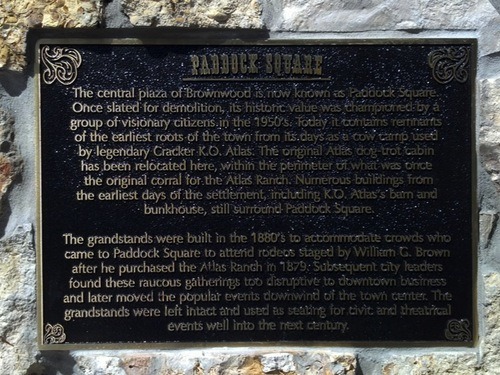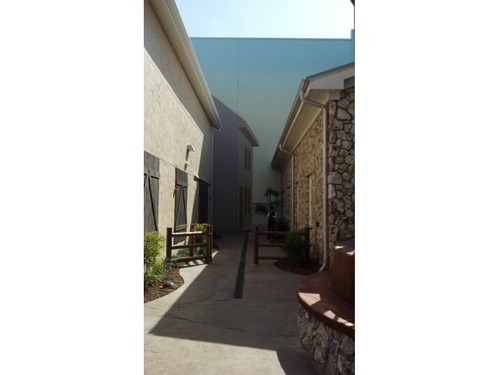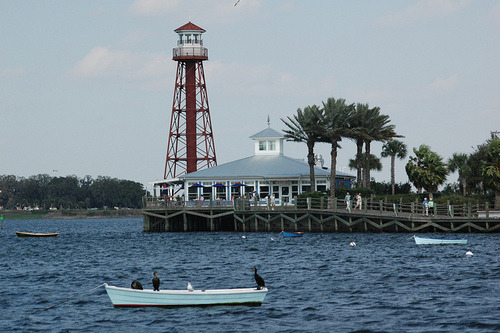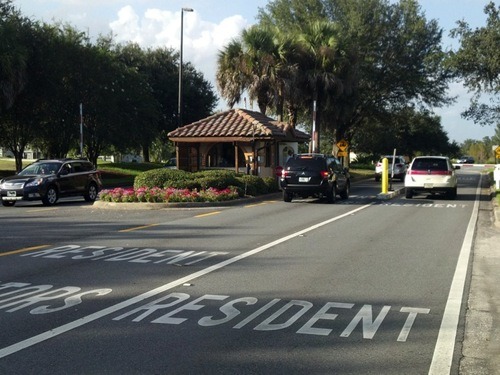Here's one more arsenal-related observation about Florida's The Villages: interestingly, most residential neighborhoods in The Villages lack curbs:
In fact, with the exception of the gravel patch in the foreground (which has a fire hydrant placed strategically on it) there is not an inch of road frontage on this street that is not a curb cut for a driveway. It's actually quite ingenious, in a Dr. Evil kind of way. We have seen how FIRE HYDRANTS, FIRE ZONES, and RESIDENTIAL PARKING PERMITS can be used to keep non-residents out of a residential neighborhood by restricting parking, but not building curbs is actually a much simpler, much more straightforward weapon for this. Not only is there no place to park - there is no place to even pull over and rest. It's bound to make any visitor feel like a 21st century Flying Dutchman.
Friday, December 28, 2012
The Blockbuster
While we're on the topic of weapons of exclusion and inclusion in pop culture, check out this fascinating All in the Family episode about blockbusting:
It's a very interesting episode, and in Part II, Meathead does a decent job of describing the blockbusting game. On the other hand, the episode's racial dynamics are pretty messed up. It is unfortunate, for example, that the writers chose to make the blockbuster black. With a black blockbuster, the lesson of the episode is that it is wrong to exploit your own people. The black man takes the heat, and the primarily white audience of the show is relieved of having to confront the racial injustice that is at the heart of blockbusting, and the essential truth revealed by the Kerner Commission just four years before this episode aired, namely, that "white society is deeply implicated in the ghetto. White institutions created it, white institutions maintain it, and white society condones it." This racial dynamic is only reinforced at the end of the episode, when Archie Bunker goes out to rally the neighborhood to not sell out and be duped by the black man.
It's a very interesting episode, and in Part II, Meathead does a decent job of describing the blockbusting game. On the other hand, the episode's racial dynamics are pretty messed up. It is unfortunate, for example, that the writers chose to make the blockbuster black. With a black blockbuster, the lesson of the episode is that it is wrong to exploit your own people. The black man takes the heat, and the primarily white audience of the show is relieved of having to confront the racial injustice that is at the heart of blockbusting, and the essential truth revealed by the Kerner Commission just four years before this episode aired, namely, that "white society is deeply implicated in the ghetto. White institutions created it, white institutions maintain it, and white society condones it." This racial dynamic is only reinforced at the end of the episode, when Archie Bunker goes out to rally the neighborhood to not sell out and be duped by the black man.
Thursday, December 27, 2012
"FOR SALE" SIGN BAN
Communities sometimes organize to try to ban "for sale" signs in front of homes. Why? What's interesting is that the "for sale" sign ban has been used to promote residential integration and segregation. Indeed the "for sale" sign ban is one of those ambiguous, double-agent weapons that--like ADULT SWIM, APARTMENT SIZE, NEIGHBORHOOD COMPOSITION RULE and others that remind us that how a weapon is used is often more important than what it is.
One the one hand, "for sale" signs can be (and indeed have been) used by unscrupulous, blockbusting real estate brokers to pedal panic in white neighborhoods. A big, colorful "for sale" sign in front of house signals a homeowner's decision to leave town; a cluster of such signs is likely to incite paranoia and fears of a racial turnover, which in turn incites white flight. Demand goes down, property values plummet, and said unscrupulous broker is standing by, ready to swoop in, buy up, and flip the properties to black families for twice what he bought them for. For this reason, the “for sale” sign ban is sometimes used by Civil Rights groups and integrationists: ban the sign, and you take away one of the blockbuster's chief tools. (Using the same argument, the same groups have also unsuccessfully tried to ban "sold" signs). But the "for sale" sign ban has also been used by racists to maintain or promote segregation. Especially in the pre-internet era, simple, handmade signs made it possible for people to sell homes without the aid of real estate brokers. Banning "for sale" signs makes it more necessary to go through brokers, who, with through their multiple listing service, segregated classifieds, and racist code of ethics, would ensure that a white home would not be sold to a black family and vice versa.
One the one hand, "for sale" signs can be (and indeed have been) used by unscrupulous, blockbusting real estate brokers to pedal panic in white neighborhoods. A big, colorful "for sale" sign in front of house signals a homeowner's decision to leave town; a cluster of such signs is likely to incite paranoia and fears of a racial turnover, which in turn incites white flight. Demand goes down, property values plummet, and said unscrupulous broker is standing by, ready to swoop in, buy up, and flip the properties to black families for twice what he bought them for. For this reason, the “for sale” sign ban is sometimes used by Civil Rights groups and integrationists: ban the sign, and you take away one of the blockbuster's chief tools. (Using the same argument, the same groups have also unsuccessfully tried to ban "sold" signs). But the "for sale" sign ban has also been used by racists to maintain or promote segregation. Especially in the pre-internet era, simple, handmade signs made it possible for people to sell homes without the aid of real estate brokers. Banning "for sale" signs makes it more necessary to go through brokers, who, with through their multiple listing service, segregated classifieds, and racist code of ethics, would ensure that a white home would not be sold to a black family and vice versa.
Sunday, December 2, 2012
GATED COMMUNITY, FAKE
We recently took a field trip to Florida's The Villages, officially the largest retirement community in the world. The Villages is fascinating for many reasons, but here we'd like to focus on one particularly Arsenal-worthy reason, namely, that fact that it is essentially fake GATED COMMUNITY.

fake shipwrecks:

fake histories:

and trompe l'oeil around every corner:

On Lake Sumter (a man-made lake), there is even a fake lighthouse!

That is to say the designers behind The Villages are great at faking it. For the most part, this is fairly benign, and even a little fun (although it can at times be a bit creepy).
But here's an instance of something really sinister: it's essentially a fake gated community. Since most of The Villages is served by State and County roads, The Villages can't be a gated community, since you cannot deny access to a public road to non-residents.
Here's how The Villages gets around this. It starts with a sign that reads "The Villages Residential Entrance."

Next to the sign is a gate and security hut:

Notice that the lane on the right is for residents while the lane on the left--nearest the security booth--is for visitors.
Again, this is a public road. How can this exist?
Basically, the whole thing is an elaborate hoax meant to make outsiders think it's a gated community (and thereby turn around): the gate opens automatically regardless of what lane you're in, and the guard has no authority to deny access to anyone (although he could presumably alert The Villages security to the infiltration of anyone who might look like they don't belong).
Now there are a lot of fake things in The Villages. There are fake train stations:

fake shipwrecks:

fake histories:

and trompe l'oeil around every corner:

On Lake Sumter (a man-made lake), there is even a fake lighthouse!

That is to say the designers behind The Villages are great at faking it. For the most part, this is fairly benign, and even a little fun (although it can at times be a bit creepy).
But here's an instance of something really sinister: it's essentially a fake gated community. Since most of The Villages is served by State and County roads, The Villages can't be a gated community, since you cannot deny access to a public road to non-residents.
Here's how The Villages gets around this. It starts with a sign that reads "The Villages Residential Entrance."

Next to the sign is a gate and security hut:

Notice that the lane on the right is for residents while the lane on the left--nearest the security booth--is for visitors.
Again, this is a public road. How can this exist?
Basically, the whole thing is an elaborate hoax meant to make outsiders think it's a gated community (and thereby turn around): the gate opens automatically regardless of what lane you're in, and the guard has no authority to deny access to anyone (although he could presumably alert The Villages security to the infiltration of anyone who might look like they don't belong).
Subscribe to:
Posts (Atom)

